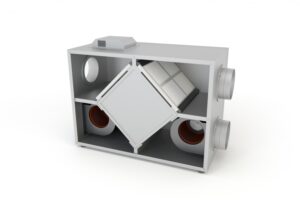Heating and cooling a home uses a lot of energy. In fact, according to the EPA, 53% of the energy usage of the average American single-family home is due to heating and cooling!
That means that keeping your climate control more efficient can save you a ton of money. And the best way to heat and cool more effectively is to weatherize your home, sealing up every draft and crack, right?
But if you seal your home up tight, humidity, contaminants, and allergens will be trapped inside. How can you get fresh air without wasting energy? An energy recovery ventilator might be exactly what you need to improve your indoor air quality while maintaining your efficiency.
Causes of Poor Indoor Air Quality
Indoor air quality, or IAQ, can be negatively impacted by a wide variety of things. Some of these are natural, though natural does not necessarily mean good. For example, mold spores are perfectly natural, but you don’t want to be breathing them, and if they build up in your home, you can end up with a very unpleasant mildew problem.
Smelly foot bacteria from shoes and cooking odors from yesterday’s fish are natural too, but not very nice. And some indoor air contaminants are not so natural, like chemical compounds that off-gas from carpet or linger after you use cleaning products. You don’t want these things to stay trapped in your house forever.
How Energy Recovery Ventilators Work
An energy recovery ventilator or ERV can be installed as part of your home’s HVAC system. It allows fresh air to enter your home and stale air to be vented out. But it does not just let cold air in to waste your energy and drive up your heating bills in winter, or let hot air in during the summer. It actually adjusts the temperature of the incoming air in an extremely energy-efficient way.
The two streams of air, incoming and outgoing, are contained in separate channels. However, those are contained against one another in such a way that the outgoing air will affect the temperature of the incoming air.
So in the summer, cool, conditioned air on its way out of your home is held against the incoming hot air to lower its temperature, and in the winter, the reverse is true. And while heat recovery ventilators only affect the temperature of the air they cycle, energy recovery ventilators in Hayden, ID also control for humidity.
How Indoor Air Quality Is Improved
With fresh air coming in and stale air going out, you’ll be able to get rid of contaminants of all varieties. Outdoor air has much lower levels of contamination than indoor air. Pet odors, sneaker stink, and other unpleasant aromas will be wafted away and you’ll be breathing fresh-smelling air.
And when humidity is kept at reasonable levels, those mold spores will have a much harder time reproducing and growing mold colonies in your home. When indoor air quality is poor, people report more frequent asthma attacks, allergy symptoms, and headaches, as well as low energy levels, difficulty sleeping, and bad moods. When that air quality is improved, the improvement in those symptoms can be absolutely amazing.
ACI Northwest is here to help with your indoor air quality. Contact us today to learn more about energy recovery ventilators.

